Virtual Plug-In Hybrid Concept Development and Optimization under Real-World Boundary Conditions
Abstract
:1. Introduction
- What is the impact of predictive controls on the powertrain limitations?
- What is the impact of hardware technologies and rule-based control adaptations on the powertrain limitations?
- By addressing these questions, this work aims to contribute to the development of future vehicles with optimized performance across real-world driving conditions.
2. Vehicle Requirements Management and Optimal Hybrid Powertrain System Design
2.1. Pre-Dimensioning and Modeling of Vehicle and Operating Strategy
2.2. Optimized Combined Plug-In Hybrid Powertrain Design
2.3. Advanced Modeling Approach
2.3.1. NVH Modeling Approach
2.3.2. Thermal Modeling Approach
2.3.3. Emissions Modeling Approach
3. Results of the Most Challenging Real-World Driving Scenarios
3.1. Simulation Results of Real-World Driving Scenarios
3.1.1. Statistical Evaluation of Component Temperatures
3.1.2. Statistical Evaluation of the Operating Modes
3.1.3. Statistical Evaluation of CO2 and ICE Noise Emissions
3.1.4. Statistical Evaluation of Pollutant and Particulate Emissions
3.1.5. Selection of Challenging Driving Scenarios
4. Optimization-Based Control Approach
4.1. Predictive Powertrain Management
4.2. Results of Predictive Powertrain Management in Real-World Driving Scenarios
5. Hardware Adjustments and Hardware Optimization
5.1. Technical Measures and Rule-Based Controls Enhancement Approach
5.1.1. Engine Torque Limitation
5.1.2. Load Point Shifting
5.1.3. Coolant Heat Storage
5.1.4. Engine Encapsulation
5.1.5. High-Voltage Battery Heater
5.1.6. Exhaust Aftertreatment System Adaptions
5.1.7. Electric Combustion Chamber Heater
5.1.8. EM and HVB Direct Cooling Approaches
5.1.9. Sodium-Ion Battery Technology
5.2. Results and Conclusions for Single Technologies
5.3. Developed Technology Packages Based on Single Technology Evaluation
5.4. Results and Conclusions for Technology Packages
6. Summary and Conclusions
Author Contributions
Funding
Data Availability Statement
Acknowledgments
Conflicts of Interest
References
- Gottorf, S.; Fryjan, J.; Leyens, L.; Picerno, M.; Habermann, K.; Pischinger, S. Lean Approach for Virtual Calibration Using Hardware-in-the-Loop and Electronic Control Unit (ECU)-Capable Engine Simulation. SAE Int. J. Engines 2021, 14, 531–542. [Google Scholar] [CrossRef]
- Andert, J.; Xia, F.; Klein, S.; Savelsberg, R.; Guse, D.; Tharmakulasingam, R.; Thewes, M.; Scharf, J. Road-to-Rig-to-Desktop—Virtual Development Using Real-Time Engine Modeling and Powertrain-Co-Simulation. COMODIA 2017, 2017, A108. [Google Scholar] [CrossRef]
- Pischinger, S.; Seiffert, U. Vieweg Handbuch Kraftfahrzeugtechnik; Springer Fachmedien Wiesbaden: Wiesbaden, Germany, 2021; ISBN 978-3-658-25556-5. [Google Scholar]
- Schäfer, S. Modellbasierte Steuerung des Kühlkreislaufes einer Brennstoffzelle mit Automatisiertem Test der Software; VDI-Verlag: Düsseldorf, Germany, 2012. [Google Scholar]
- Platner, S.; Kordon, M.; Fakiolas, E.; Atzler, H. Modellbasierte Serien-kalibrierung—Der effiziente Weg für Variantenentwicklung. MTZ Mot. Z. 2013, 74, 754–761. [Google Scholar] [CrossRef]
- Basshuysen, R.; Schäfer, F. Handbuch Verbrennungsmotor: Grundlagen, Komponenten, Systeme, Perspektiven, 8th ed.; Springer Vieweg: Wiesbaden, Germany, 2017; ISBN 978-3-658-10902-8. [Google Scholar]
- Seibel, J. Optimierte Auslegung von Ottomotoren in Hybrid-Antriebsträngen. Ph.D. Thesis, RWTH Aachen University, Aachen, Germany, 2008. [Google Scholar]
- Balazs, A. Optimierte Auslegung von Ottomotorischen Hybridantriebssträngen unter Realen Fahrbedingungen. Ph.D. Thesis, RWTH Aachen University, Aachen, Germany, 2015. [Google Scholar]
- Böhmer, M. Simulation der Abgasemissionen von Hybridfahrzeugen für Reale Fahrbedingungen. Ph.D. Thesis, RWTH Aachen University, Aachen, Germany, 2017. [Google Scholar]
- Ao, G.-Q.; Qiang, J.-X.; Zhong, H.; Mao, X.-J.; Yang, L.; Zhuo, B. Fuel economy and NO x emission potential investigation and trade-off of a hybrid electric vehicle based on dynamic programming. Proc. Inst. Mech. Eng. Part D J. Automob. Eng. 2008, 222, 1851–1864. [Google Scholar] [CrossRef]
- Chen, Z.; Mi, C.C. An adaptive online energy management controller for power-split HEV based on Dynamic Programming and fuzzy logic. In Proceedings of the VPPC ’09, 2009 IEEE Vehicle Power and Propulsion Conference (VPPC), Dearborn, MI, USA, 7–10 September 2009; IEEE: Piscataway, NJ, USA, 2009; pp. 335–339, ISBN 978-1-4244-2600-3. [Google Scholar]
- Dextreit, C.; Assadian, F.; Kolmanovsky, I.V.; Mahtani, J.; Burnham, K. Hybrid Electric Vehicle Energy Management Using Game Theory. In Proceedings of the SAE Technical Paper Series, SAE World Congress & Exhibition, SAE International400 Commonwealth Drive, Warrendale, PA, USA, 14 April 2008. [Google Scholar]
- Jeon, S.; Jo, S.; Park, Y.; Lee, J. Multi-Mode Driving Control of a Parallel Hybrid Electric Vehicle Using Driving Pattern Recognition. J. Dyn. Syst. Meas. Control 2002, 124, 141–149. [Google Scholar] [CrossRef]
- Danzer, C.; Voigt, T.; Forell, A.; Schreiterer, E.; Kockisch, R.; Sens, M.; Schneider, E. System simulation and visualization of powertrain and mobility concepts. In Experten-Forum Powertrain: Simulation und Test 2020; Springer Vieweg: Berlin/Heidelberg, Germany, 2021; pp. 1–15. [Google Scholar]
- Teuschl, G.; Ebner, P.; Huss, A.; de Kerpel, N. Simulationsgestütze systemische Entwicklung hybrider Antriebssysteme. MTZ Mot. Z. 2021, 82, 78–83. [Google Scholar] [CrossRef]
- Häußler, L. Generisches Fahrzeug Energiemanagement. Ph.D. Thesis, RWTH Aachen University, Aachen, Germany, 2021. [Google Scholar]
- Weiß, F. Optimale Konzeptauslegung elektrifizierter Fahrzeugantriebsstränge. Ph.D. Thesis, Technische Universität Chemnitz, Chemnitz, Germany, 2017. [Google Scholar] [CrossRef]
- Maurer, R.; Kossioris, T.; Sterlepper, S.; Günther, M.; Pischinger, S. Zero-Impact Tailpipe Emission Powertrains: Identify Technical Solutions to Achieve Powertrains with Zero-Impact Tailpipe Emissions under Consideration of a 2030+ Legislative Vehicle and Air Pollutant Scenario; Final Report 1338; FVV e.V.: Frankfurt am Main, Germany, 2023. [Google Scholar]
- Pischinger, S.; Genender, P.; Klopstein, S.; Hemkemeyer, D. Aufgaben beim Thermomanagement von Hybrid- und Elektrofahrzeugen. ATZ Automob. Z. 2014, 116, 54–59. [Google Scholar] [CrossRef]
- Uhlmann, T.; Balazs, A.; Lückmann, D.; Müller, A.; Thewes, M.; Sahr, C.; Pischinger, J.; Hellenbroich, G.; Herold, K.L.; Lüdiger, T. High Efficient Gasoline HEV Meeting 2030 CO2 Targets—The Road towards 59 g/km Fleet CO2. In Proceedings of the 29th Aachen Colloquium Sustainable Mobility, Aachen, Germany, 5–7 October 2020; Aachener Kolloquium Fahrzeug- und Motorentechnik GbR: Aachen, Germany, 2020. ISBN 978-3-00-064871-7. [Google Scholar]
- Eichlseder, W.; Hager, J.; Raup, M.; Dietz, S. Auslegung von Kuehlsystemen Mittels Simulationsrechnung. Automob. Z. 1997, 99, 638–647. [Google Scholar]
- Knauf, B.; Pantow, E. Auslegung eines Kühlsystems mit elektrischer Kühlmittelpumpe. MTZ Mot. Z. 2005, 66, 878–884. [Google Scholar] [CrossRef]
- Eilemann, A. Thermomanagement—Eine Systemaufgabe. ATZ Automob. Z. 2015, 117, 86. [Google Scholar] [CrossRef]
- Banjac, T.; Wurzenberger, J.C.; Katrašnik, T. Assessment of engine thermal management through advanced system engineering modeling. Adv. Eng. Softw. 2014, 71, 19–33. [Google Scholar] [CrossRef]
- Setlur, P.; Wagner, J.R.; Dawson, D.M.; Marotta, E. An Advanced Engine Thermal Management System: Nonlinear Control and Test. IEEE/ASME Trans. Mechatron. 2005, 10, 210–220. [Google Scholar] [CrossRef]
- Lu, L.; Chen, H.; Hu, Y.; Gong, X.; Zhao, Z. Modeling and Optimization Control for an Engine Electrified Cooling System to Minimize Fuel Consumption. IEEE Access 2019, 7, 72914–72927. [Google Scholar] [CrossRef]
- Weiss, M.; Tuncay, V.; Richter, S.; Broz, J. Umfassende Simulation und vernetzte Intelligenz im Thermomanagement. MTZ Mot. Z. 2017, 78, 42–49. [Google Scholar] [CrossRef]
- Kang, H.; Ahn, H.; Min, K. Smart cooling system of the double loop coolant structure with engine thermal management modeling. Appl. Therm. Eng. 2015, 79, 124–131. [Google Scholar] [CrossRef]
- Appel, N.; Brinker, M.; Soetje, H.; Müller, T. Aktives Antriebsstrang-Thermomanagement beim Opel Insignia. MTZ Mot. Z. 2020, 81, 60–65. [Google Scholar] [CrossRef]
- Beste, F. Thermisch-Elektrische Analyse und Ableitung von Verbesserungsmaßnahmen für den Elektrischen Antrieb eines Plug-In-Hybridfahrzeugs, 1st ed.; Cuvillier Verlag: Göttingen, Germany, 2016; ISBN 9783736983021. [Google Scholar]
- Shutty, J.; Bongards, A.; Kondipati, N.; Ristevski, S. Thermomanagement bei elektrifizierten Antriebssystemen. ATZ Automob. Z. 2022, 124, 38–43. [Google Scholar] [CrossRef]
- Müller, J.; Maurer, R.; Achenbach, J.; Balazs, A.; Knauf, J. Antriebsstrangoptimierung von Hybridsystemen unter Berücksichtigung thermischer Einzelkomponentenwirkungsgrade. In Experten-Forum Powertrain: Reibung in Antrieb und Fahrzeug 2020; Liebl, J., Ed.; Springer Vieweg: Berlin/Heidelberg, Germany, 2020; pp. 179–201. [Google Scholar]
- Ernstberger, U.; Weissinger, J.; Frank, J. (Eds.) Mercedes-Benz SL: Entwicklung und Technik; Springer Fachmedien Wiesbaden: Wiesbaden, Germany, 2013; ISBN 978-3-658-00799-7. [Google Scholar]
- Kexel, J.; Müller, J. HyFlex-ICE: Highly Flexible Internal Combustion Engines for Hybrid Vehicles; Final Report 1338; FVV: Frankfurt am Main, Germany, 2023. [Google Scholar]
- Hick, H.; Küpper, K.; Sorger, H. Systems Engineering for Automotive Powertrain Development, 1st ed.; Springer International Publishing: Cham, Switzerland, 2021; ISBN 978-3-319-99628-8. [Google Scholar]
- Kexel, J.; Müller, J.; Günther, M.; Pischinger, S. HyFlex-ICE: Highly Flexible Internal Combustion Engines for Hybrid Vehicles. In Proceedings of the International Stuttgart Symposium, Stuttgart, Germany, 4–5 July 2023; Kulzer, A.-C., Reuss, H.-C., Wagner, A., Eds.; Springer Vieweg: Wiesbaden, Germany, 2023; pp. 243–272. [Google Scholar]
- Maiterth, J.M. Gesamtkosten- und Emissionsoptimierte Systemauslegung von Nutzfahrzeug-Hybridantriebssträngen. Ph.D. Thesis, RWTH Aachen University, Aachen, Germany, 2022. [Google Scholar]
- Granrath, C.; Kugler, C.; Silberg, S.; Meyer, M.-A.; Orth, P.; Richenhagen, J.; Andert, J. Feature-driven systems engineering procedure for standardized product-line development. Syst. Eng. 2021, 24, 456–479. [Google Scholar] [CrossRef]
- Gräßler, I.; Oleff, C. Systems Engineering: Verstehen und Industriell Umsetzen; Springer Vieweg: Berlin, Germany, 2022. [Google Scholar]
- Werra, M.; Sturm, A.; Küçükay, F. Optimal and prototype dimensioning of 48V P0+P4 hybrid drivetrains. Automot. Engine Technol. 2020, 5, 173–186. [Google Scholar] [CrossRef]
- Maurer, R.; Kossioris, T.; Sterlepper, S.; Günther, M.; Pischinger, S. Achieving Zero-Impact Emissions with a Gasoline Passenger Car. Atmosphere 2023, 14, 313. [Google Scholar] [CrossRef]
- Balazs, A. Untersuchung zur Optimierten Auslegung von Abschlussbericht Hybridantriebsträngen unter Realen Fahrbedingungen (F1011); FVV-Informationstagung: Frankfurt am Main, Germany, 2013. [Google Scholar]
- Seibel, J.; Pischinger, S. Abschlussbericht zum Vorhaben Untersuchung zur Optimierten Auslegung von Ottomotoren in Hybrid-Antriebsträngen (F863); Informationstagung Motoren, Heft R 537; FVV: Frankfurt am Main, Germany, 2007. [Google Scholar]
- Vaillant, M. Design Space Exploration zur Multikriteriellen Optimierung Elektrischer Sportwagenantriebsstränge; KIT Scientific Publishing: Karlsruhe, Germany, 2015; ISBN 978-3-7315-0452-8. [Google Scholar]
- Siebertz, K.; van Bebber, D.; Hochkirchen, T. Statistische Versuchsplanung; Springer: Berlin/Heidelberg, Germany, 2017; ISBN 978-3-662-55742-6. [Google Scholar]
- FEV Software and Testing Solutions. Doe Software with Global Map Optimization Gaussian Process Model. 2022. Available online: https://www.fev-sts.com/fileadmin/user_upload/STS/Brochure-Catalog_2022/FEV-STS_Brochure_xCAL_2022.pdf (accessed on 9 November 2022).
- Fröhlingsdorf, K.; Doleschal, F. Final Report: Characteristics for Quantifying the Annoyance of Interference Noise in the Compartment of Vehicles with an Electric Drive System (Interference Noise in the Vehicle Compartment with Electrified Drives), FVV 1369; FVV Transfer + Networking Event R603; FVV: Würzburg, Germany, 2022. [Google Scholar]
- Fröhlingsdorf, K.; Doleschal, F. Interference Noise in the Vehicle Compartment with Electrified Drives: Characteristics for Quantifying the Annoyance of Interference Noise in the Compartment of Vehicles with an Electric Drive System; Final Report 1327; FVV: Frankfurt am Main, Germany, 2023. [Google Scholar]
- Müller, J.; Besser, N.; Hermsen, P.; Pischinger, S.; Knauf, J.; Bagherzade, P.; Fryjan, J.; Balazs, A.; Gottorf, S. Virtual Development of Advanced Thermal Management Functions Using Model-in-the-Loop Applications. Energies 2023, 16, 3238. [Google Scholar] [CrossRef]
- Müller, J.; Balazs, A.; Knauf, J.; Gottorf, S.; Besser, N.; Fryjan, J. Advanced Thermal Management Models for X-in-the-Loop Applications—A Gamechanger for Control Unit Function Development; SAE Thermal Management Systems; SAE: Warrendale, PA, USA, 2021. [Google Scholar]
- Fanger, P.O. Thermal Comfort: Analysis and Applications in Environmental Engineering; Reprint; Krieger: Malabar, FL, USA, 1982; ISBN 0898744466. [Google Scholar]
- ASHRAE. ANSI/ASHRAE Addendum d to ANSI/ASHRAE Standard 55-2017: Thermal Environmental Conditions for Human Occupancy; ASHRAE: Peachtree Corners, GA, USA, 2017. [Google Scholar]
- Karrar, E. Untersuchungen zum Reibungsverhalten und Ölverbrauch der Kolbengruppe von Verbrennungsmotoren: Lehrstuhl für Verbrennungskraftmaschinen und Institut für Thermodynamik. Ph.D. Thesis, RWTH Aachen, Aachen, Germany, 2009. [Google Scholar]
- Baumgarten, H.; Scharf, J.; Thewes, M.; Uhlmann, T.; Balazs, A.; Böhmer, M. Simulation-Based Development Methodology for Future Emission Legislation. In Proceedings of the 37th International Vienna Motor Symposium, Vienna, Austria, 28–29 April 2016; Lenz, H.P., Ed.; Fortschritt-Berichte VDI: Düsseldorf, Germany, 2016. ISBN 978-3-18-379912-1. [Google Scholar]
- Maurer, R.; Yadla, S.K.; Balazs, A.; Thewes, M.; Walter, V.; Uhlmann, T. Designing Zero Impact Emission Vehicle Concepts. In Experten-Forum Powertrain: Reibung in Antrieb und Fahrzeug; Liebl, J., Ed.; Springer Vieweg: Berlin/Heidelberg, Germany, 2020; pp. 75–116. [Google Scholar]
- Thewes, M.; Balazs, A.; Yadla, S.K.; Walter, V.; Görgen, M.; Scharf, J.; Sterlepper, S.; Voßhall, T. Zero-Impact combustion engine. In Proceedings of the 28th Aachen Colloquium Sustainable Mobility, Aachen, Germany, 7–9 October 2019; Aachener Kolloquium Fahrzeug- und Motorentechnik GbR: Aachen, Germany, 2019. ISBN 978-3-00-060311-2. [Google Scholar]
- Kexel, J.; Müller, J.; Günther, M.; Pischinger, S. Real-World Driving Scenarios for Optimal System Design. Mendeley Data, 2024. [Google Scholar] [CrossRef]
- Schyr, C.; Spreitzer, H. Digitaler Streckenatlas für die alpine Antriebsstrangerprobung. Automot. Eng. Partn. 2004, 1, 44–47. [Google Scholar]
- Gesundheitsberichterstattung des Bundes. Körpermaße der Bevölkerung. Available online: https://www.gbe-bund.de/gbe/pkg_isgbe5.prc_menu_olap?p_uid=gast&p_aid=47463195&p_sprache=D&p_help=0&p_indnr=223&p_indsp=&p_ityp=H&p_fid= (accessed on 18 October 2023).
- Hopp. Thermomanagement von Hochleistungsfahrzeug-Traktionsbatterien anhand Gekoppelter Simulationsmodelle; Springer Fachmedien Wiesbaden: Wiesbaden, Germany, 2016; ISBN 978-3-658-14246-9. [Google Scholar]
- Korthauer, R. (Ed.) Handbuch Lithium-Ionen-Batterien; Springer: Berlin/Heidelberg, Germany, 2013; ISBN 978-3-642-30653-2. [Google Scholar]
- Küpfmüller, K.; Kohn, G. Theoretische Elektrotechnik und Elektronik: Eine Einführung, 15th ed.; Springer: Berlin/Heidelberg, Germany, 2000; ISBN 978-3-540-67794-9. [Google Scholar]
- Reif, K. Ottomotor-Management: Steuerung, Regelung und Überwachung, 4th ed.; Springer Vieweg: Wiesbaden, Germany, 2014; ISBN 978-3-8348-1416-6. [Google Scholar]
- Etikyala, S.; Dahlander, P. Soot Sources in Warm-Up Conditions in a GDI Engine. SAE Technical Paper 2021-01-0622. 2021. Available online: https://www.sae.org/publications/technical-papers/content/2021-01-0622/ (accessed on 25 October 2023).
- Sun, C.; Moura, S.J.; Hu, X.; Hedrick, J.K.; Sun, F. Dynamic Traffic Feedback Data Enabled Energy Management in Plug-in Hybrid Electric Vehicles. IEEE Trans. Contr. Syst. Technol. 2015, 23, 1075–1086. [Google Scholar] [CrossRef]
- Fleming, P.J.; Pursehouse, R.C. Genetic Algorithms in Control Systems Engineering. IFAC Proc. Vol. 1993, 26, 605–612. [Google Scholar] [CrossRef]
- Du, X.; Htet, K.K.K.; Tan, K.K. Development of a Genetic-Algorithm-Based Nonlinear Model Predictive Control Scheme on Velocity and Steering of Autonomous Vehicles. IEEE Trans. Ind. Electron. 2016, 63, 6970–6977. [Google Scholar] [CrossRef]
- Nobis, C.; Kuhnimhof, T. Mobilität in Deutschland—MiD. Ergebnisbericht: Eine Studie von Infas, DLR, IVT und Infas 360 im Auftrag des Bundesministers für Verkehr und Digitale Infrastruktur (FE-Nr. 70.904/15); Bundesministerium für Verkehr und digitale Infrastruktur: Bonn, Berlin, 2018. [Google Scholar]
- Kraft, W.; Altstedde, M.K. Use of metallic Phase Change Materials (mPCM) for heat storage in Electric- and Hybrid Vehicles. In Proceedings of the 6th Hybrid and Electric Vehicles Conference (HEVC 2016), London, UK, 2–3 November 2016; Institution of Engineering and Technology: London, UK, 2016. ISBN 978-1-78561-294-7. [Google Scholar]
- Lichius, T. Latentwärmespeicher in PlugIn-Hybridfahrzeugen. Ph.D. Thesis, RWTH Aachen University, Aachen, Germany, 2017. [Google Scholar]
- Spengler, R.; Essers, U. Einsatzmöglichkeiten von Kunststoff-Teilkapseln an Verbrennungsmotoren. MTZ Mot. Z. 1999, 60, 164–170. [Google Scholar] [CrossRef]
- Röchling Automotive SE & Co. KG. Leichte Kapselung hält Motor länger auf Betriebstemperatur. Lightweight Des. 2013, 6, 8. [CrossRef]
- Moos, E. Kostenabschätzung für eine Motorkapselung der Firma Röchling. E-Mail. 2022. [Google Scholar]
- Warner, B. High Voltage Coolant Heater.
- ATT Advanced Thermal Technologies. Battery Heating Solutions. Available online: https://www.thermaltech.at/battery-heating/ (accessed on 25 October 2023).
- Frenzelit GmbH. Revolutionäre Heizfolien und Heizsysteme aus Innovativem Verbundmaterial. Available online: https://www.frenzelit.com/produkte/hicotec/hicotec-tp-thermal-power (accessed on 25 October 2023).
- Flextem GmbH. PTC—Heiztechnologie. Available online: https://www.flextem.de/de/folienheizungen/ptc-heizfolien.html (accessed on 25 October 2023).
- Rose, D.; Boger, T.; Wu, H.; Ingram-Ogunwumi, R. Neue Generation Otto-Partikelfilter. MTZ Mot. Z. 2021, 82, 60–64. [Google Scholar] [CrossRef]
- Rolf Brück. Niedrigstemissionen im Realbetrieb: Lösungen für elektrifizierte Ottomotoren. In Proceedings of the 28th Aachen Colloquium Sustainable Mobility, Aachen, Germany, 7–9 October 2019; Aachener Kolloquium Fahrzeug- und Motorentechnik GbR: Aachen, Germany, 2019. [Google Scholar]
- ZVEI-Task Force Spannungsklassen. Spannungsklassen in der Elektromobilität. Available online: https://www.zvei.org/fileadmin/user_upload/Presse_und_Medien/Publikationen/2014/januar/Spannungsklassen_in_der_Elektromobilitaet/Spannungsklassen-Elektromobilitaet.pdf (accessed on 19 October 2023).
- Kevin Bennion and Gilberto Moreno: NREL. Convective Heat Transfer Coefficients of Automatic Transmission Fluid Jets with Implications for Electric Machine Thermal Management: Preprint. Available online: https://www.nrel.gov/docs/fy15osti/63969.pdf (accessed on 26 October 2023).
- Shams Ghahfarokhi, P.; Podgornovs, A.; Kallaste, A.; Marques Cardoso, A.J.; Belahcen, A.; Vaimann, T. The Oil Spray Cooling System of Automotive Traction Motors: The State of the Art. IEEE Trans. Transp. Electrific. 2023, 9, 428–451. [Google Scholar] [CrossRef]
- Peters, J.; Peña Cruz, A.; Weil, M. Exploring the Economic Potential of Sodium-Ion Batteries. Batteries 2019, 5, 10. [Google Scholar] [CrossRef]
- Dhaussy, F.; Truong Canh, J.; Raynaud, Y.; El Mejdoubi, A. High Power Battery Systems for Mild-Hybrid with Sodium-ion cobalt free technology. In Proceedings of the 31st Aachen Colloquium Sustainable Mobility, Aachen, Germany, 10–12 October 2022; Aachener Kolloquium Fahrzeug- und Motorentechnik GbR: Aachen, Germany, 2022. Paper No. 05. ISBN 978-3-00-072524-1. [Google Scholar]
- Stalp, A.; Heinz, A. Partikelbildung bei DI-Ottomotoren: Systemische Analyse der Partikelbildung an Ottomotoren, FF 1223. 2020. [Google Scholar]
- Günter Fischer, P. Betriebspunktorientierte Analyse und Optimierung der Partikelrohemissionen an einem Turboaufgeladenen Ottomotor. Ph.D. Thesis, Otto-von-Guericke-Universität Magdeburg, Magdeburg, Germany, 2020. [Google Scholar]
- Ascheberg, C. Die Sigma Milieus®, das Globale Zielgruppen und Trend System; Unveröffentlichtes Textmanuskript; Sigma: Mannheim, Germany, 2005. [Google Scholar]
- Brokate, J.; Özdemir, E.D.; Kugler, U. Der Pkw-Markt bis 2040: Was das Auto von Morgen Antreibt: Szenario-Analyse im Auftrag des Mineralölwirtschaftsverbandes. Available online: https://www.dlr.de/dlr/Portaldata/1/Resources/documents/2013/DLR-Studie_Pkw-Markt_2040_MQPBDJRL7FdcF45_(1).pdf (accessed on 12 October 2023).

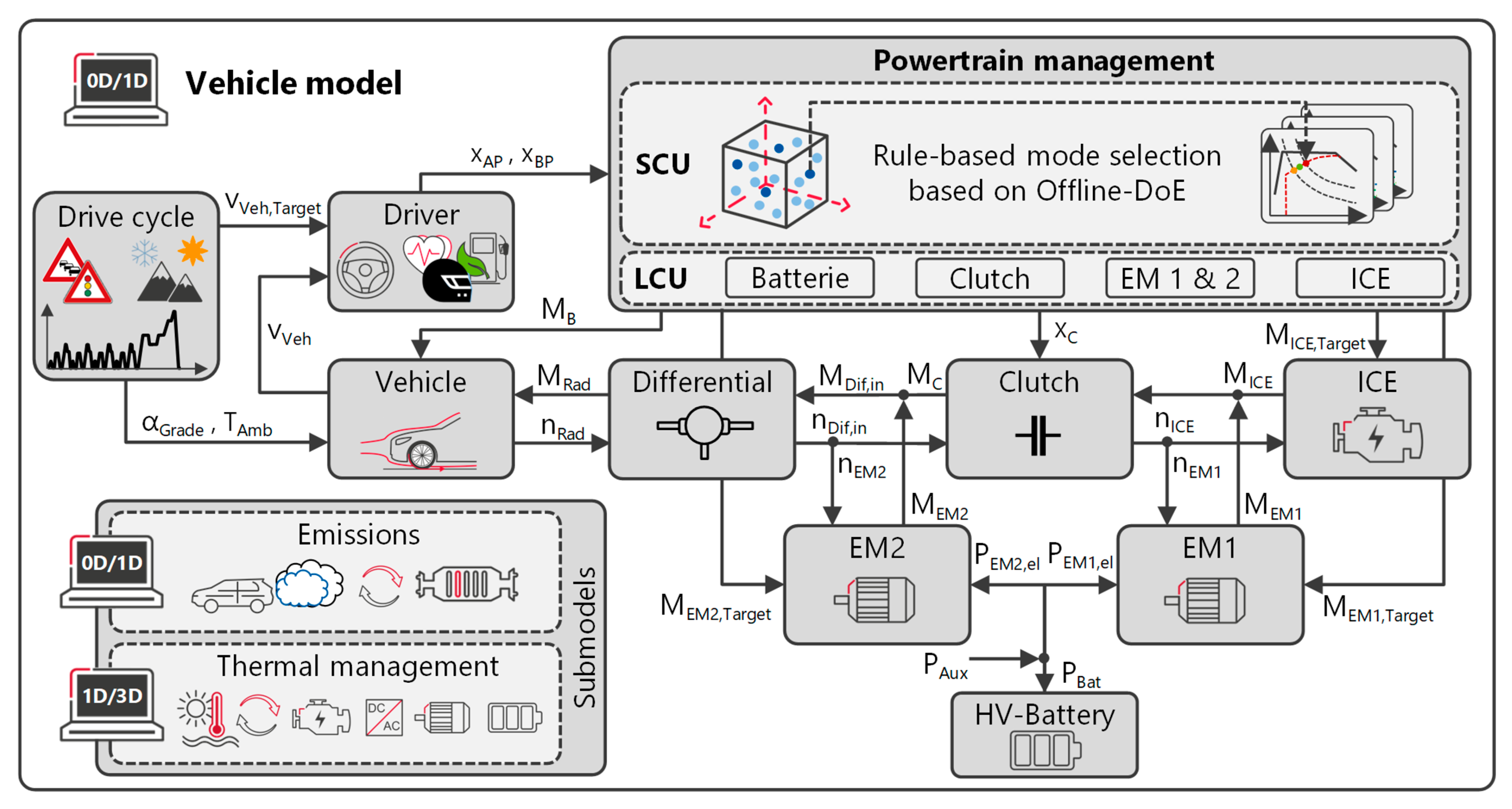
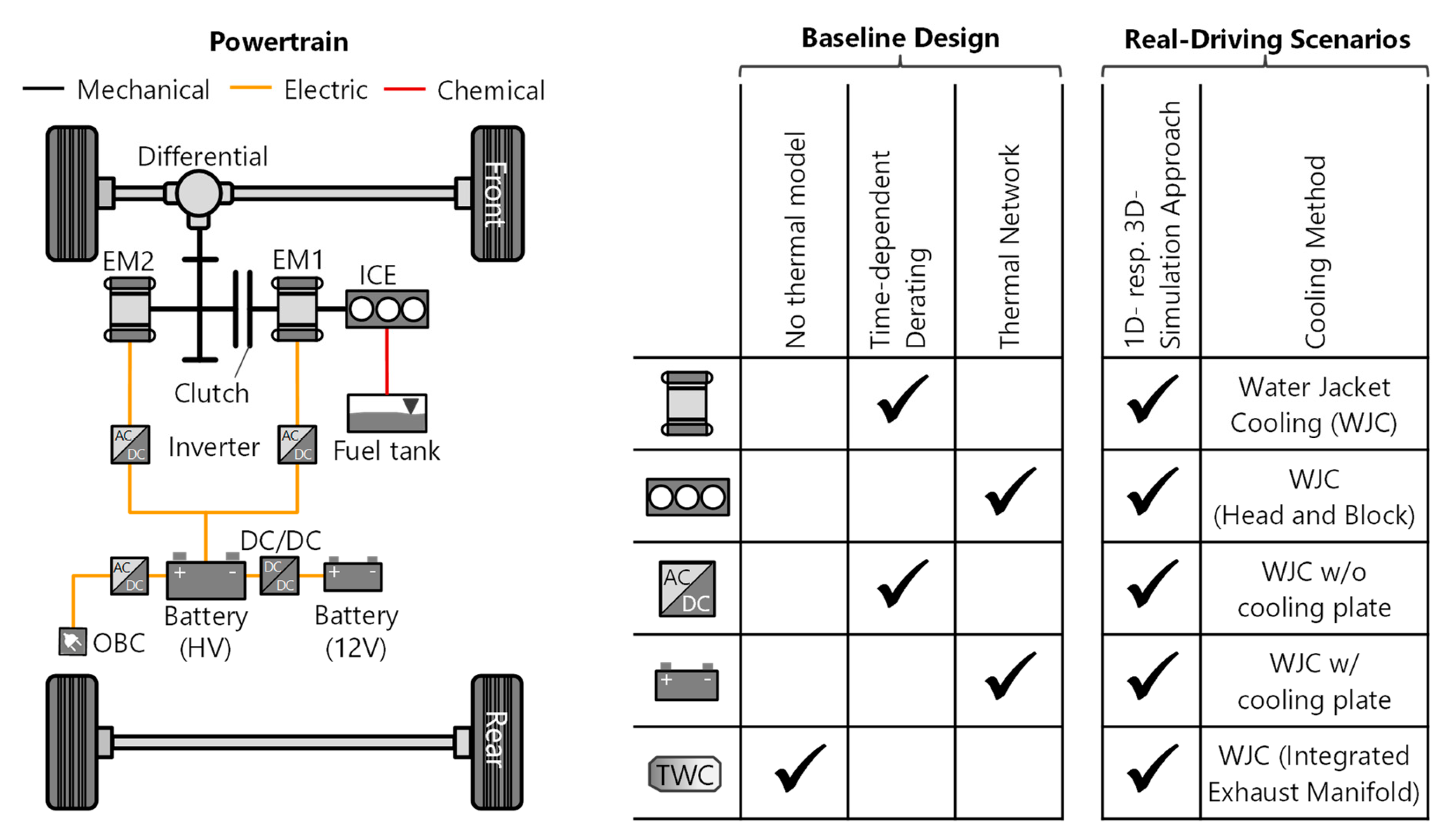
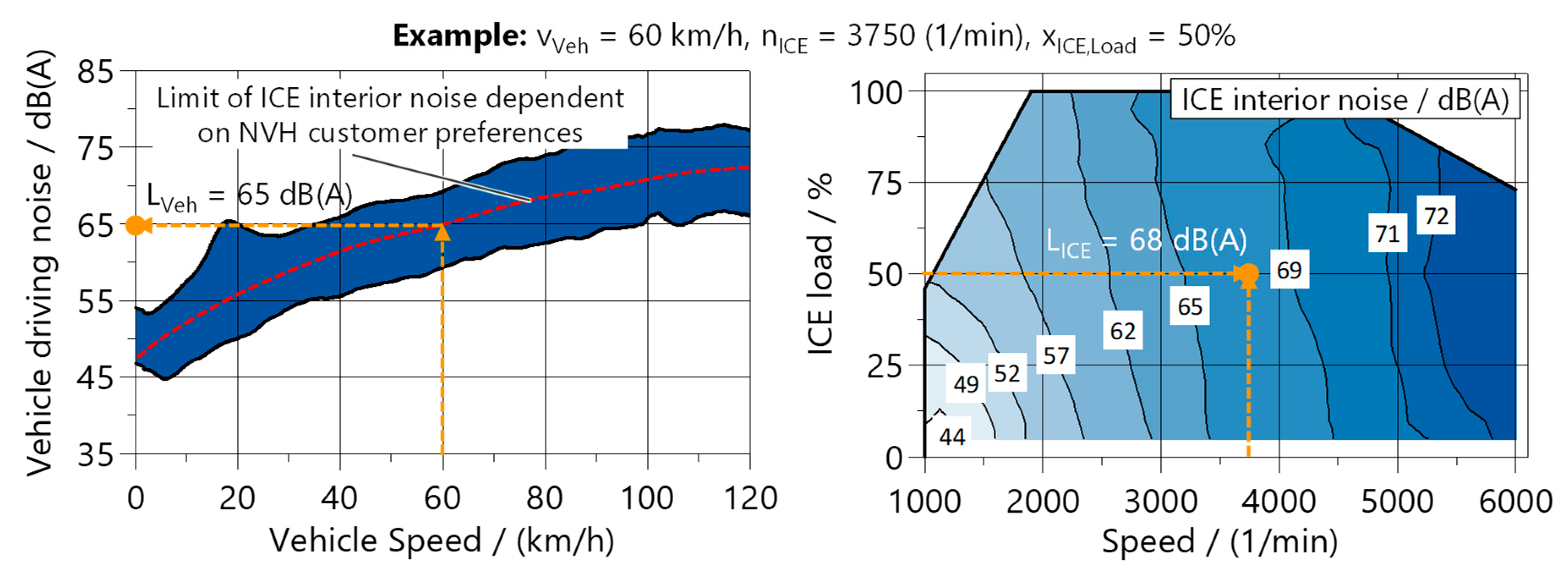
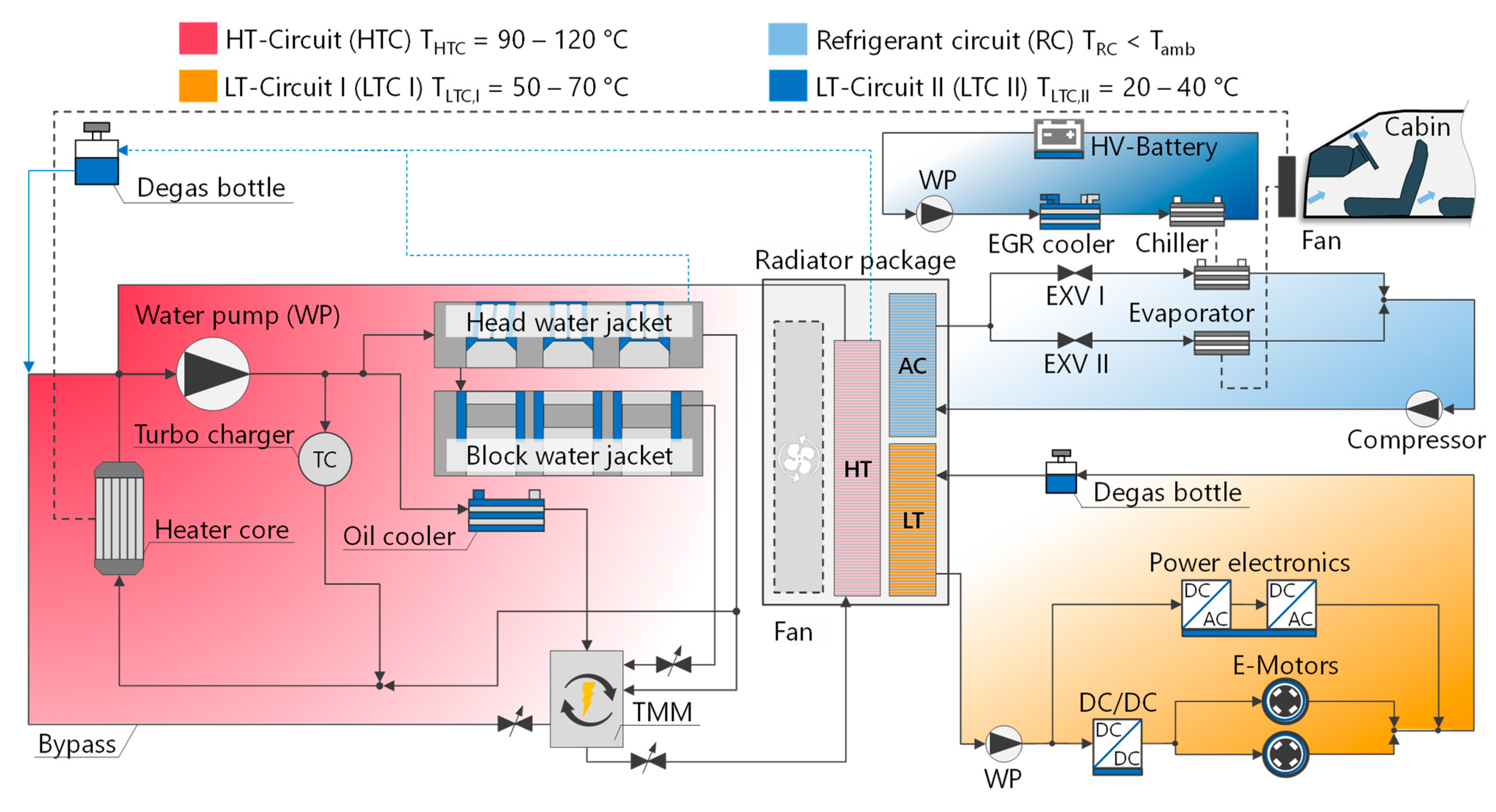
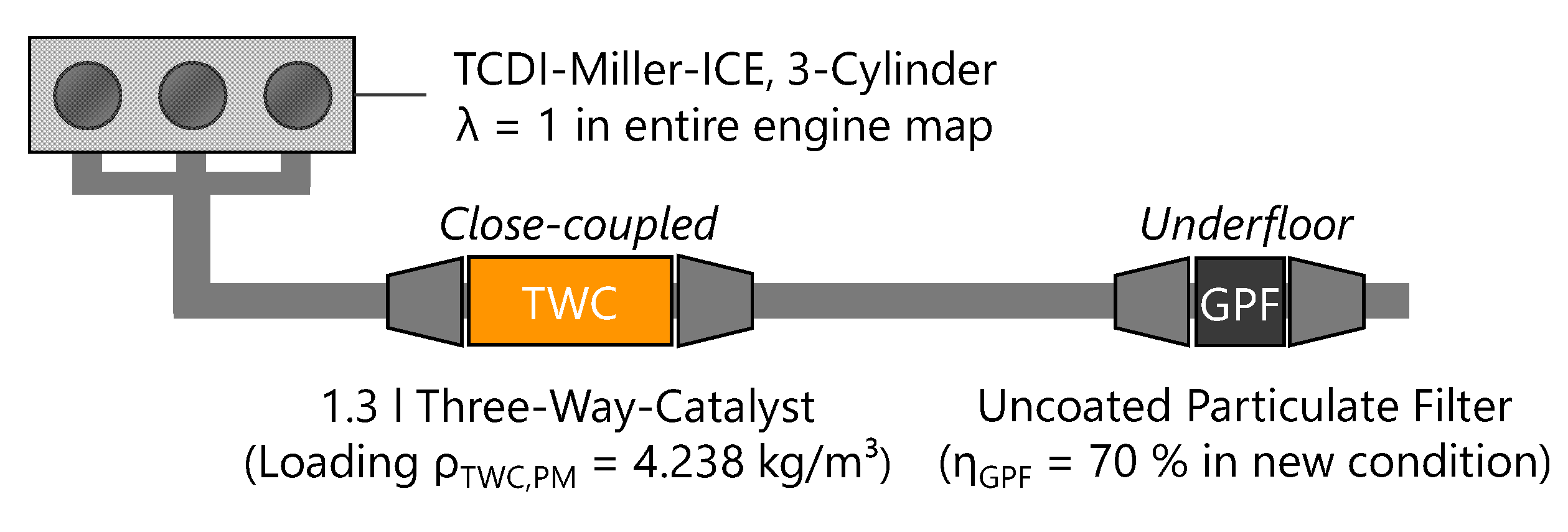

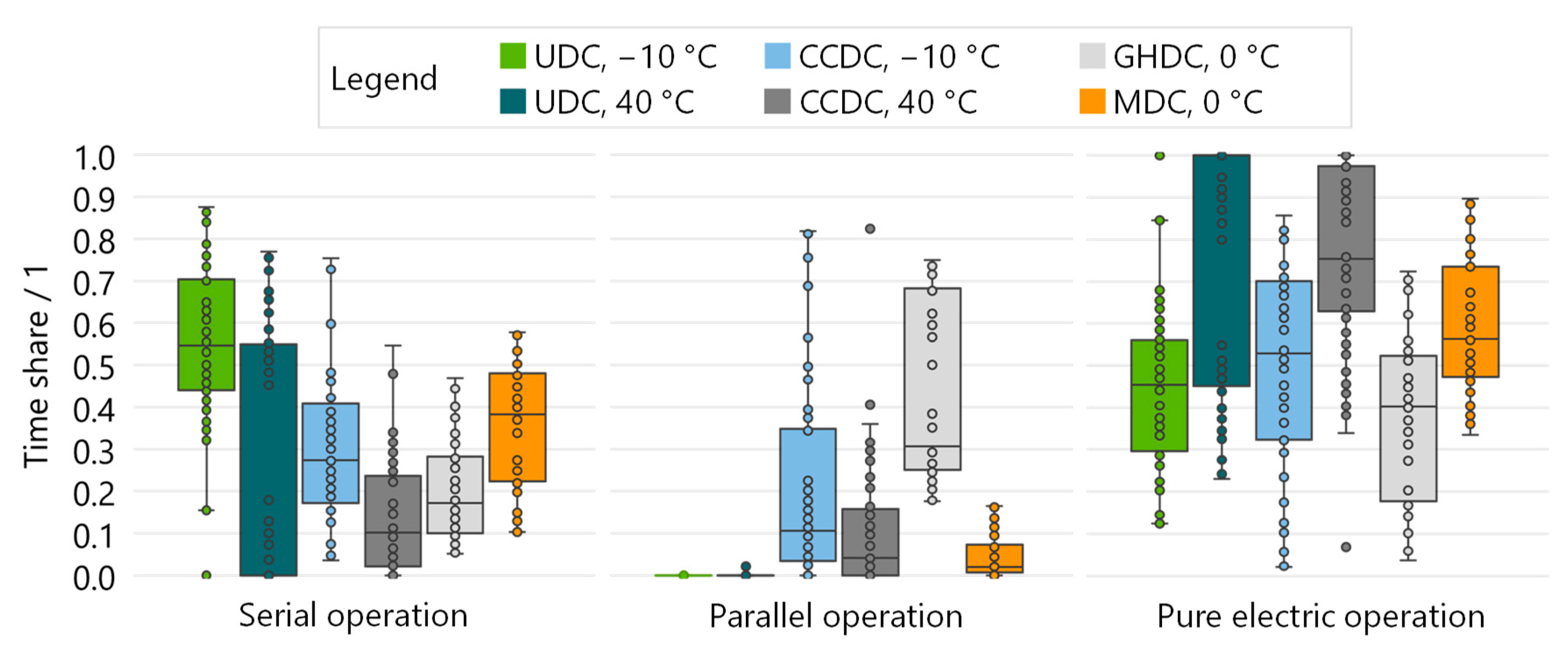

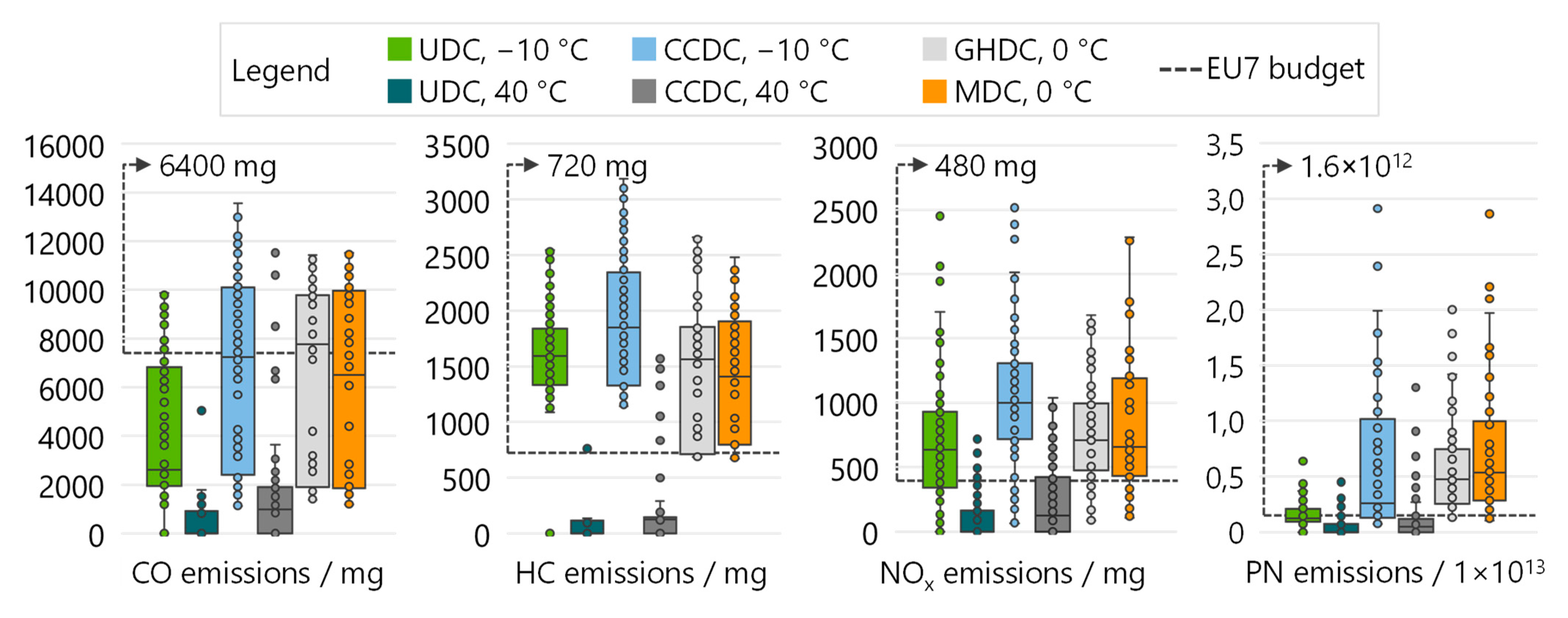
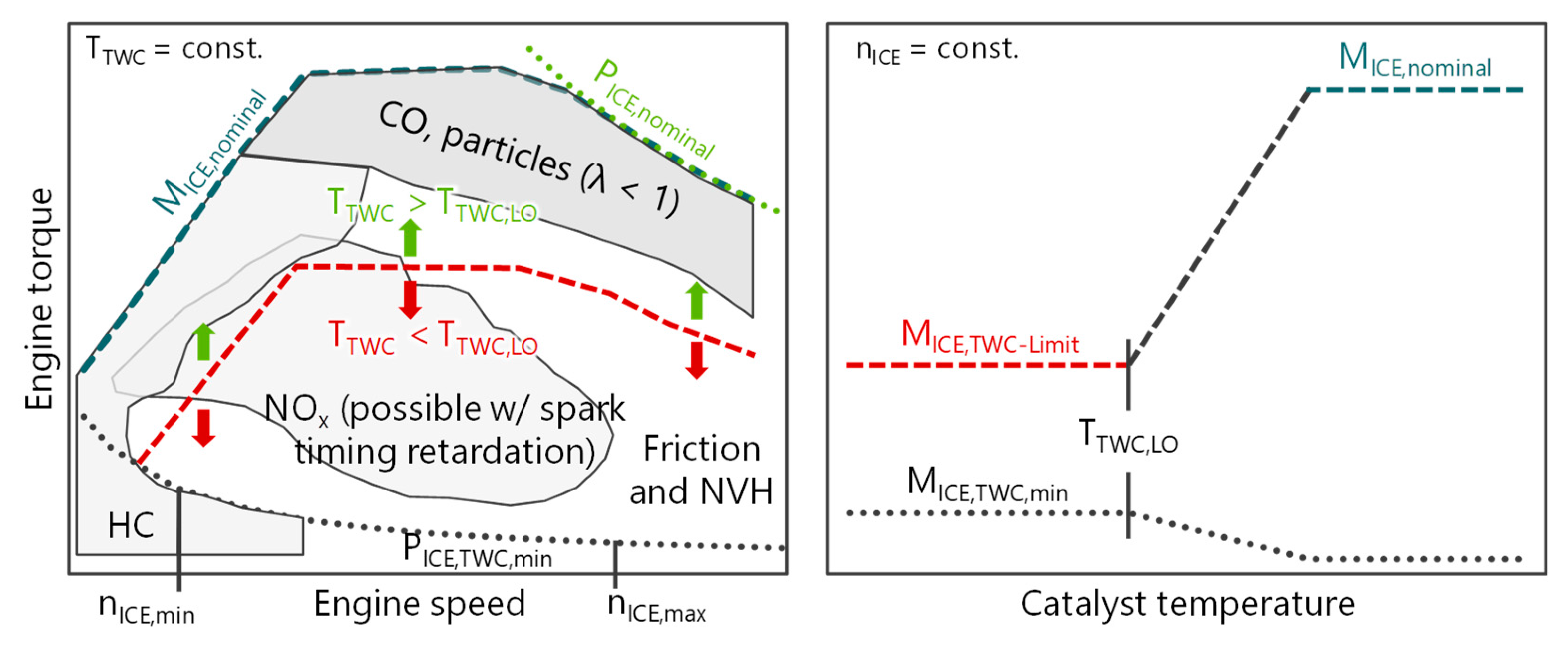
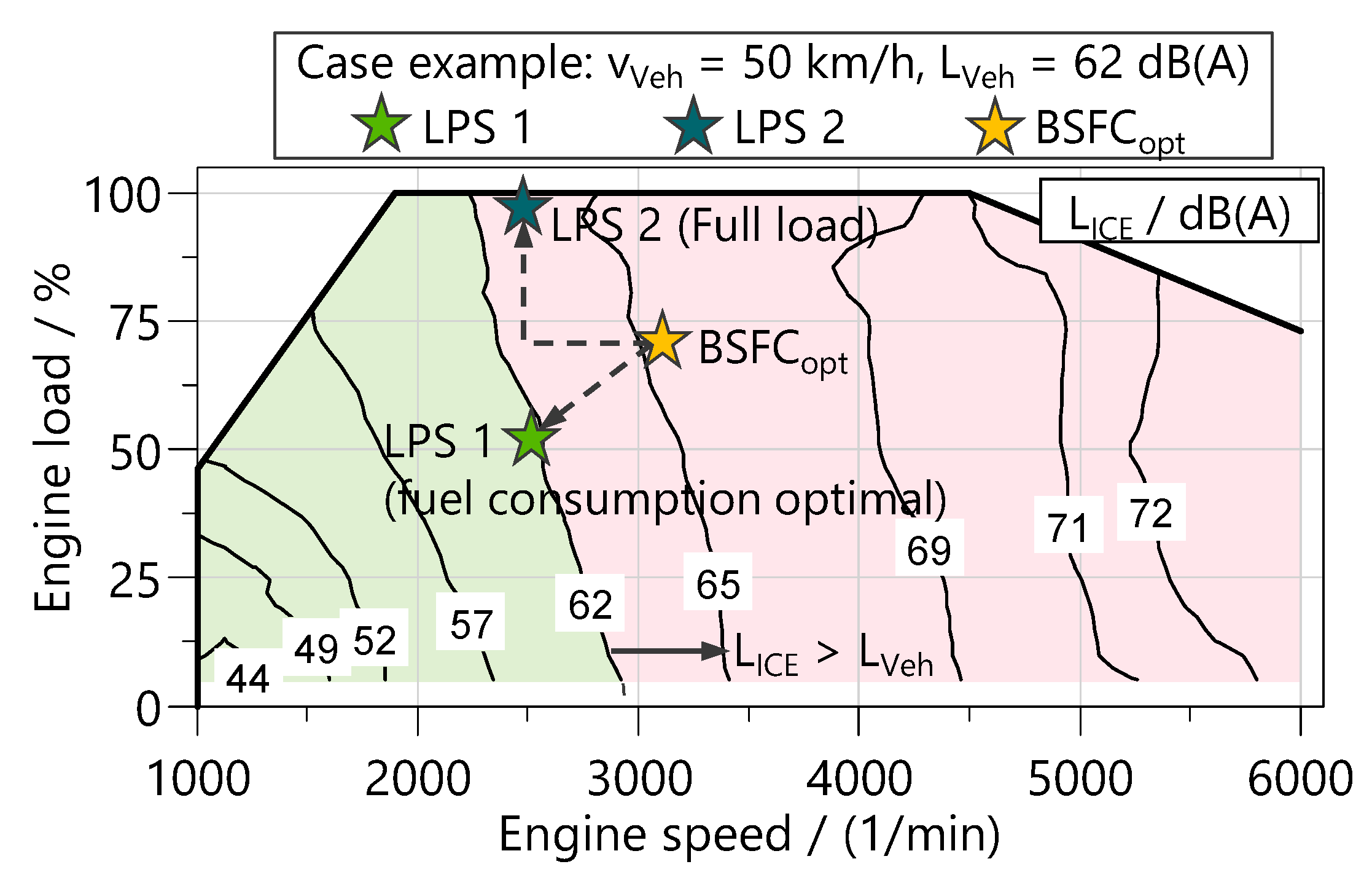
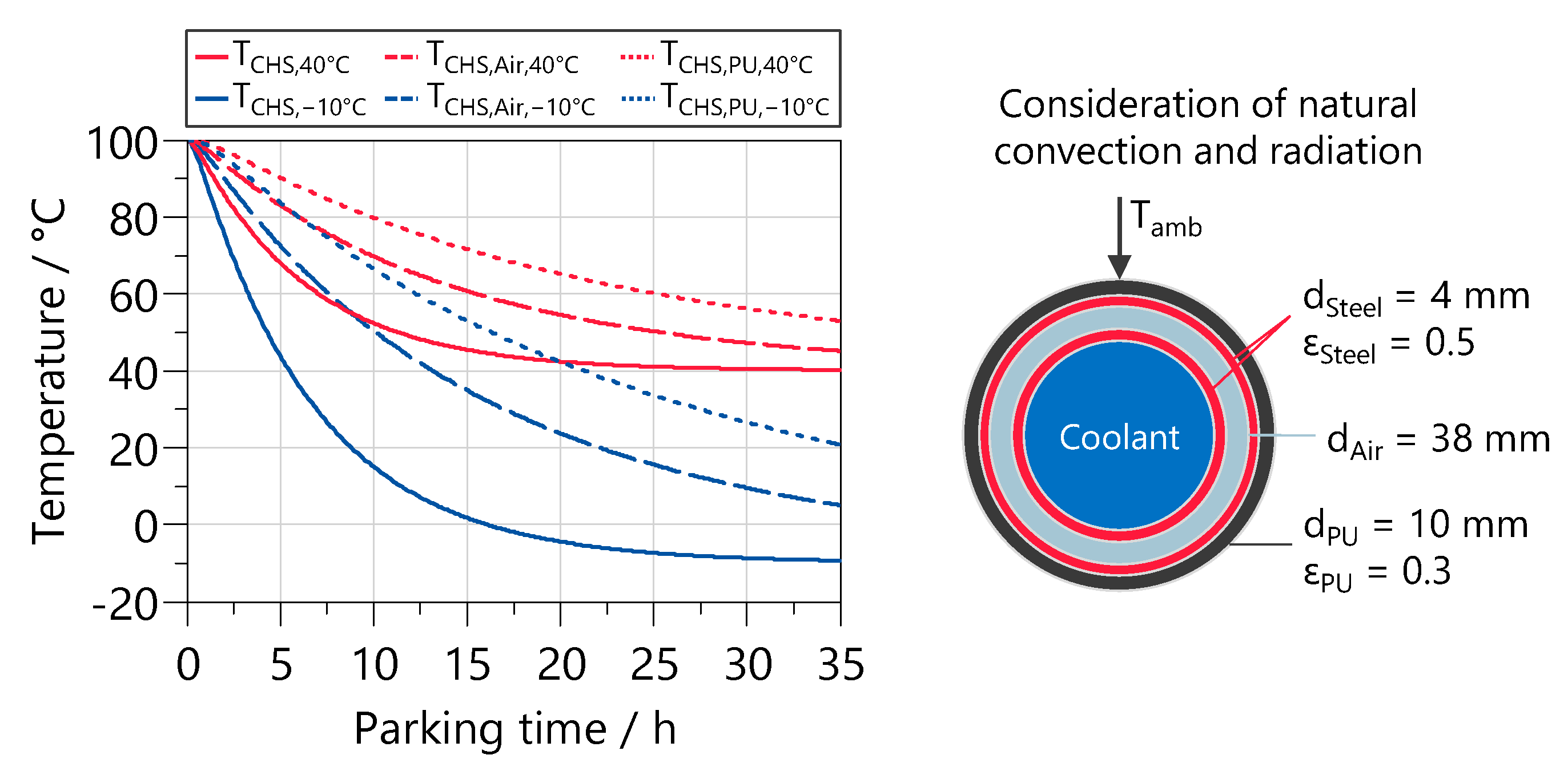
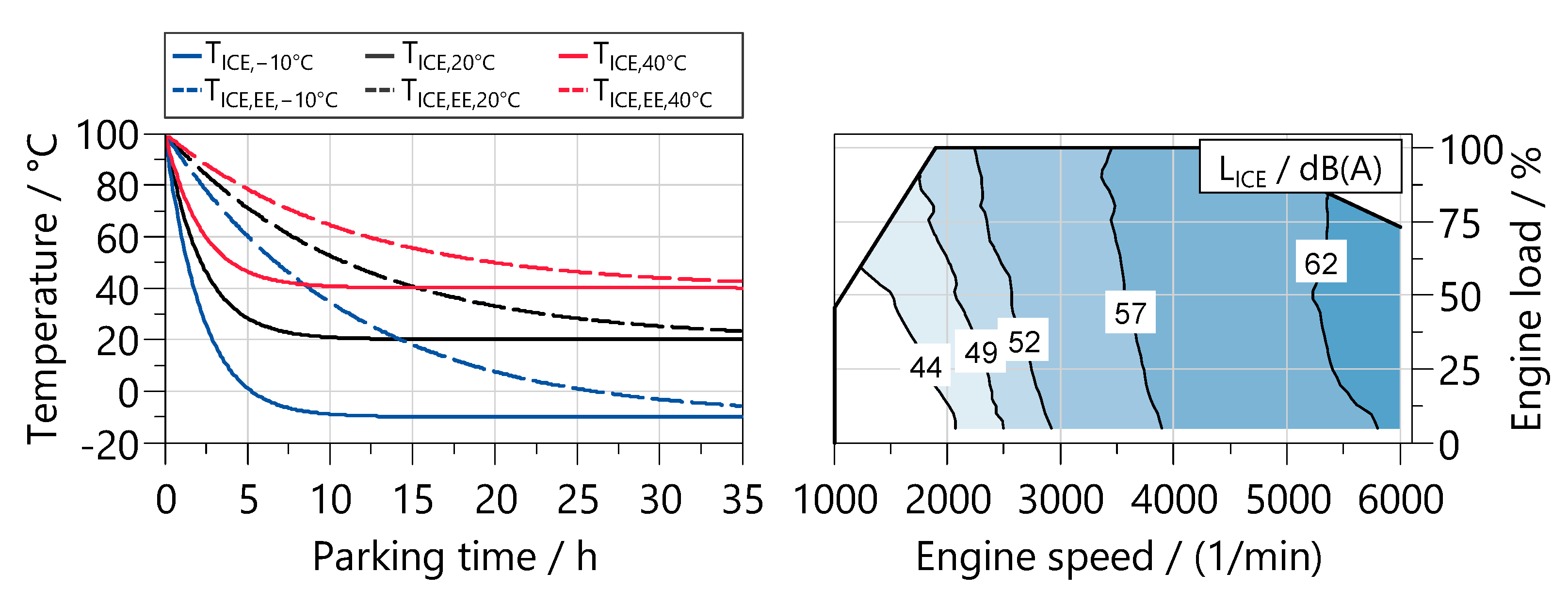


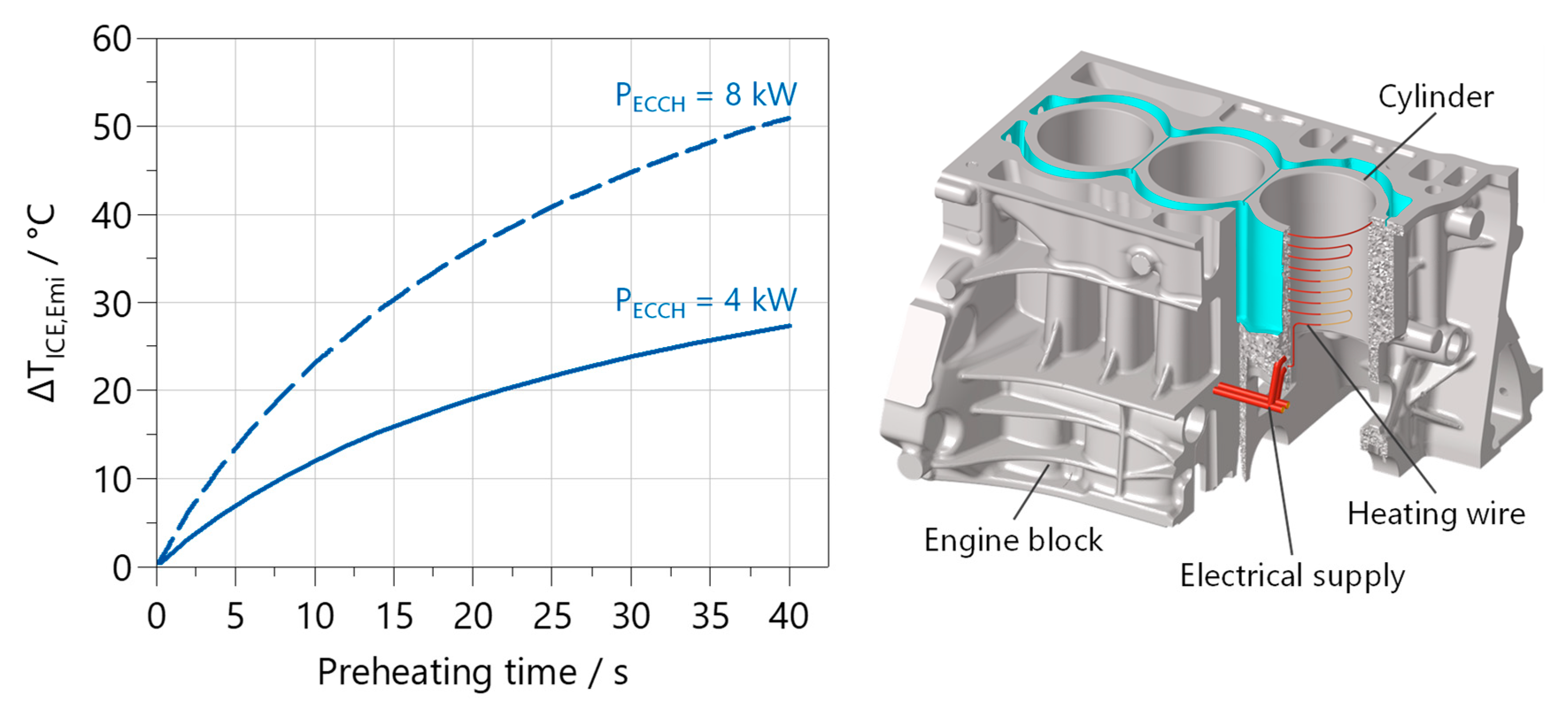



| Parameter | Value | Unit | |
|---|---|---|---|
| Vehicle, C-Segment SUV | Mass | 1.84 | t |
| Drag coefficient | 0.75 | m2 | |
| Rolling resistance | 8.1 | kg/t | |
| ICE, 3-Cyl. DI TC | Displacement | 1.4 | L |
| Rated power | 105 | kW | |
| Generator (EM2), PMSM | Max. power | 115 | kW |
| Torque-to-Power ratio | 2.0 | Nm/kW | |
| E-Motor (EM2), PMSM | Max. power | 246 | kW |
| Torque-to-Power ratio | 3.8 | Nm/kW | |
| Battery | Energy (NMC cell) | 14.7 | kWh |
| Final Drive | Gear ratio | 3.7 | 1 |
| Parameter | UDC | CCDC | GHDC | MDC |
|---|---|---|---|---|
| Ambient temperature | −10 °C | −10 °C | 0 °C | 0 °C |
| 40 °C | 40 °C | |||
| State-of-charge | 17% | 17% | 17% | 17% |
| 50% | 50% | 50% | 50% | |
| 95% | 95% | 95% | 95% | |
| Vehicle payload | 76 kg | 76 kg | 76 kg | 76 kg |
| 349 kg | 349 kg | 349 kg | 349 kg | |
| Trailer | 750 kg | 750 kg | 750 kg | 750 kg |
| Traffic | No traffic | No traffic | No traffic | No traffic |
| Low traffic | Low traffic | Low traffic | Low traffic | |
| High traffic | High traffic | High traffic | High traffic | |
| Driver type | Defensive | Defensive | Defensive | Defensive |
| Dynamic | Dynamic | Dynamic | Dynamic |
| Driving Scenario | CO2 g/km | SOC % | Duration s | NVH mJ/m2 | CO 1 mg | HC 1 mg | NOx 1 mg | PN 1 1 × 1012 |
|---|---|---|---|---|---|---|---|---|
| Baseline WLTC/Legal limits | 109/95 | - | - | 0.028/- | -/6400 | -/720 | -/480 | -/1.60 |
| Cold CCDC I 2 | 298.5 | 15.5 | 2828 | 2.679 | 3140 | 1825 | 925 | 10.6 |
| Cold CCDC II 3 | 138.8 | 24.4 | 4161 | 0.368 | 6553 | 1872 | 730 | 1.72 |
| Hot UDC I 4 | 128.8 | 28.2 | 754 | 0.336 | 1789 | 108 | 179 | 2.30 |
| Hot CCDC I 5 | 54.8 | 34.8 | 2789 | 0.630 | 8494 | 1328 | 287 | 7.42 |
| Relative Difference MPC–RB EMS | Hot UDC I Tamb = 40 °C THVB,init = 40 °C | Cold CCDC I Tamb = −10 °C THVB,init = −10 °C | Cold CCDC I Tamb = −10 °C THVB,init = 30 °C |
|---|---|---|---|
| CO2 emissions | −12.9% | −3.0% | −4.6% |
| Electric energy consumption | 4.8% | −103.6% | 131.4% |
| Total energy consumption | −1.6% | −3.7% | −0.6% |
| HVB state-of-charge | −1.1% | 2.3% | −3.6% |
| NOx tailpipe emissions 1 | −14.0% | −28.4% | −31.5% |
| HC tailpipe emissions 1 | 25.0% | −5.8% | −2.9% |
| CO tailpipe emissions 1 | −9.3% | −2.2% | 0.6% |
| PN tailpipe emissions 1 | −64.1% | −12.3% | −17.7% |
| Time share electric mode | −3.0% | −5.0% | −2.5% |
| Time share serial mode | 4.6% | 3.6% | 6.6% |
| Time share parallel mode | −1.6% | 1.4% | 4.1% |
| NVH—exceedance of masking noise | −96.2% | −17.1% | −29.0% |
| Driving Scenario | CO2 g/km | SOC % | Duration s | NVH mJ/m2 | CO 1 mg | HC 1 mg | NOx 1 mg | PN 1 1 × 1012 | |
|---|---|---|---|---|---|---|---|---|---|
| Baseline WLTC/Legal limits | 109/95 | - | - | 0.028/- | -/6400 | -/720 | -/480 | -/1.60 | |
| Cold CCDC I | 293.6 | 15.5 | 2833 | 3.791 | 3463 | 1608 | 1037 | 14.3 | |
| ICE torque limitation | 292.9 | 15.5 | 2844 | 3.798 | 2199 | 1050 | 439 | 14.5 | |
| Load point shifting | Variant 1 | 244.3 | 12.8 | 3044 | 0 | 1647 | 1171 | 760 | 3.44 |
| Variant 2 | 298.8 | 15.3 | 2850 | 3.619 | 6048 | 1339 | 792 | 14.1 | |
| Coolant heat storage | w/o pre-heating | 291.4 | 15.5 | 2833 | 3.781 | 2824 | 1071 | 1010 | 13.7 |
| with pre-heating | 291.3 | 15.5 | 2857 | 3.779 | 3216 | 907 | 950 | 13.6 | |
| ICE encapsulation | 288.0 | 15.5 | 2833 | 0.004 | 1987 | 132 | 915 | 12.9 | |
| GPF 2nd generation | 293.6 | 15.6 | 2833 | 3.790 | 2426 | 1329 | 772 | 3.16 | |
| HVB PTC heater | Variant 1 | 274.1 | 18.3 | 2833 | 3.471 | 3361 | 1645 | 1034 | 14.3 |
| Variant 2 | 252.0 | 19.6 | 2833 | 3.088 | 3708 | 1645 | 1007 | 13.6 | |
| Electric heated catalyst (EHC) | 4 kW w/o pre-heating | 294.1 | 15.6 | 2833 | 3.784 | 3770 | 1525 | 683 | 14.3 |
| 8 kW w/o pre-heating | 294.6 | 15.5 | 2833 | 3.790 | 3439 | 1472 | 584 | 14.4 | |
| EHC & secondary air pump | 4 kW w/pre-heating | 293.8 | 15.6 | 2833 | 3.791 | 3288 | 817 | 550 | 14.3 |
| 8 kW w/pre-heating | 293.9 | 15.6 | 2833 | 3.789 | 1936 | 336 | 158 | 14.4 | |
| Electric combustion chamber heater | 294.6 | 15.0 | 2833 | 3.791 | 3051 | 368 | 887 | 13.5 | |
| Sodium-ion battery technology | 296.4 | 14.2 | 2854 | 2.779 | 2480 | 1447 | 1249 | 9.88 | |
| Driving Scenario | CO2 g/km | SOC % | Duration s | NVH mJ/m2 | CO 1 mg | HC 1 mg | NOx 1 mg | PN 1 1 × 1012 | |
|---|---|---|---|---|---|---|---|---|---|
| Baseline WLTC/Legal limits | 109/95 | - | - | 0.028/- | -/6400 | -/720 | -/480 | -/1.60 | |
| Cold CCDC II | 136.8 | 24.5 | 4160 | 0.529 | 7318 | 1775 | 829 | 2.07 | |
| ICE torque limitation | 135.3 | 24.2 | 4160 | 0.525 | 1629 | 915 | 232 | 2.00 | |
| Load point shifting | Variant 1 | 125.6 | 20.7 | 4168 | 0 | 4417 | 1557 | 670 | 1.61 |
| Variant 2 | 151.2 | 25.7 | 4160 | 0.062 | 9746 | 1380 | 449 | 5.26 | |
| TWC heating strategy | 139.1 | 24.5 | 4160 | 0.368 | 2248 | 1521 | 780 | 1.66 | |
| HVB heater | Variant 1 | 106.8 | 15.7 | 4160 | 0.447 | 7354 | 1820 | 1019 | 1.91 |
| Variant 2 | 99.5 | 15.4 | 4160 | 0.376 | 7643 | 1819 | 896 | 1.82 | |
| Sodium-ion cell technology | 134.1 | 17.4 | 4158 | 0.471 | 2386 | 1325 | 124 | 2.32 | |
| Driving Scenario | CO2 g/km | SOC % | Duration s | NVH mJ/m2 | CO 1 mg | HC 1 mg | NOx 1 mg | PN 1 1 × 1012 |
|---|---|---|---|---|---|---|---|---|
| Baseline WLTC/Legal limits | 109/95 | - | - | 0.028/- | -/6400 | -/720 | -/480 | -/1.60 |
| Hot Country II | 54.8 | 34.8 | 2789 | 0.630 | 8494 | 1328 | 287 | 7.42 |
| ICE torque limitation | 56.4 | 35.5 | 2792 | 0.531 | 1602 | 163 | 100 | 5.44 |
| TWC heating strategy | 47.4 | 33.2 | 2793 | 0 | 7217 | 917 | 246 | 5.94 |
| HVB direct cooling | 47.4 | 28.6 | 2784 | 0.303 | 7749 | 1309 | 280 | 4.61 |
| EM direct cooling | 54.8 | 35.5 | 2788 | 0.614 | 8618 | 1329 | 286 | 7.38 |
| HVB and EM direct cooling | 44.6 | 28.5 | 2784 | 0.363 | 7749 | 1309 | 280 | 4.61 |
| Cost Neutral | Cold Country | Hot Country | Premium |
|---|---|---|---|
|
|
|
|
| 0€ | 273€ | 108€ | 437€ |
| Driving Scenario | CO2 g/km | SOC % | Duration s | NVH mJ/m2 | CO 1 mg | HC 1 mg | NOx 1 mg | PN 1 1 × 1012 |
|---|---|---|---|---|---|---|---|---|
| Baseline WLTC/Legal limits | 109/95 | - | - | 0.028/- | -/6400 | -/720 | -/480 | -/1.60 |
| Cold CCDC I | 293.6 | 15.5 | 2833 | 3.791 | 3463 | 1608 | 1037 | 14.33 |
| Cost neutral | 243.4 | 12.8 | 3053 | 0 | 1163 | 960 | 187 | 0.96 |
| Cold country with 30 s pre-heating | 229.4 | 13.8 | 2833 | 0 | 1082 | 448 | 169 | 0.91 |
| Premium with 30 s pre-heating | 210.1 | 15.3 | 2833 | 0 | 957 | 134 | 158 | 0.81 |
| Cold CCDC II | 136.8 | 24.5 | 4160 | 0.529 | 7318 | 1775 | 829 | 2.07 |
| Cost neutral | 125.2 | 20.6 | 4168 | 0 | 1130 | 897 | 109 | 0.40 |
| Cold country with 30 s pre-heating | 100.8 | 13.7 | 4161 | 0 | 754 | 270 | 33 | 0.34 |
| Premium with 30 s pre-heating | 93.3 | 13.9 | 4161 | 0 | 745 | 52 | 22 | 0.22 |
| Driving Scenario | CO2 g/km | SOC % | Duration s | NVH mJ/m2 | CO 1 mg | HC 1 mg | NOx 1 mg | PN 1 1 × 1012 |
|---|---|---|---|---|---|---|---|---|
| Baseline WLTC/Legal limits | 109/95 | - | - | 0.028/- | -/6400 | -/720 | -/480 | -/1.60 |
| Hot Country | 54.8 | 34.8 | 2789 | 0.630 | 8494 | 1328 | 287 | 7.42 |
| Cost neutral | 48.7 | 33.5 | 2793 | 0 | 1825 | 146 | 97 | 1.07 |
| Hot country with 30 s pre-heating | 38.1 | 26.5 | 2785 | 0 | 1070 | 135 | 91 | 0.41 |
| Premium with 30 s pre-heating | 37.0 | 26.1 | 2785 | 0 | 604 | 44 | 3 | 0.27 |
Disclaimer/Publisher’s Note: The statements, opinions and data contained in all publications are solely those of the individual author(s) and contributor(s) and not of MDPI and/or the editor(s). MDPI and/or the editor(s) disclaim responsibility for any injury to people or property resulting from any ideas, methods, instructions or products referred to in the content. |
© 2024 by the authors. Licensee MDPI, Basel, Switzerland. This article is an open access article distributed under the terms and conditions of the Creative Commons Attribution (CC BY) license (https://creativecommons.org/licenses/by/4.0/).
Share and Cite
Kexel, J.; Müller, J.; Herkenrath, F.; Hermsen, P.; Günther, M.; Pischinger, S. Virtual Plug-In Hybrid Concept Development and Optimization under Real-World Boundary Conditions. Vehicles 2024, 6, 1216-1248. https://doi.org/10.3390/vehicles6030058
Kexel J, Müller J, Herkenrath F, Hermsen P, Günther M, Pischinger S. Virtual Plug-In Hybrid Concept Development and Optimization under Real-World Boundary Conditions. Vehicles. 2024; 6(3):1216-1248. https://doi.org/10.3390/vehicles6030058
Chicago/Turabian StyleKexel, Jannik, Jonas Müller, Ferris Herkenrath, Philipp Hermsen, Marco Günther, and Stefan Pischinger. 2024. "Virtual Plug-In Hybrid Concept Development and Optimization under Real-World Boundary Conditions" Vehicles 6, no. 3: 1216-1248. https://doi.org/10.3390/vehicles6030058








